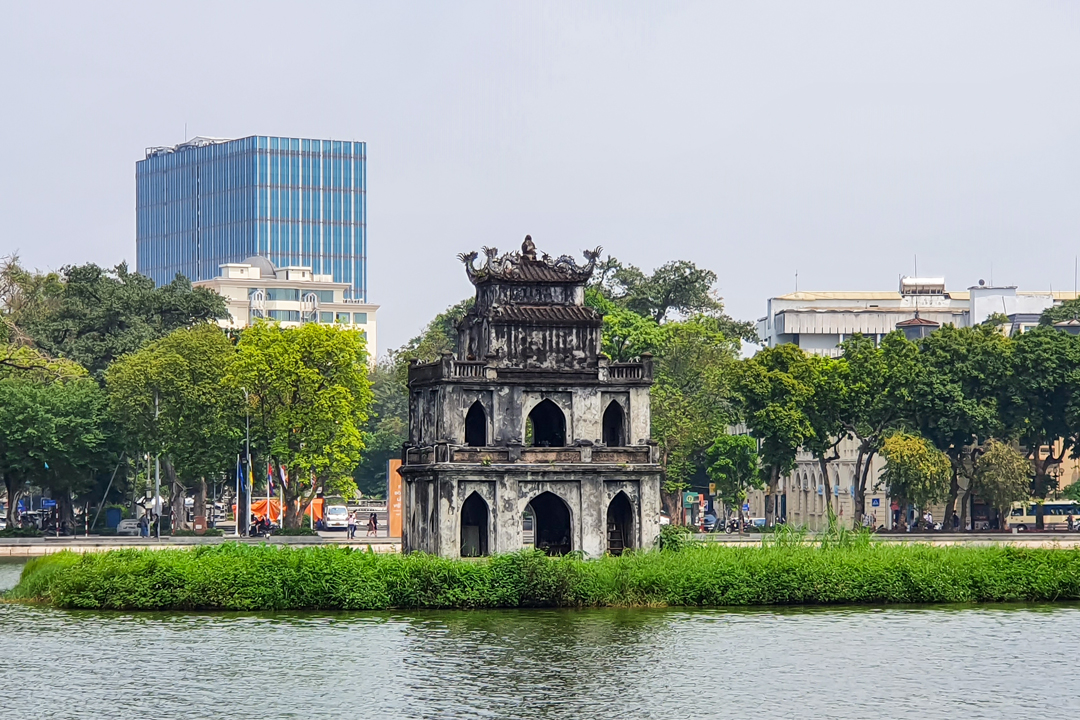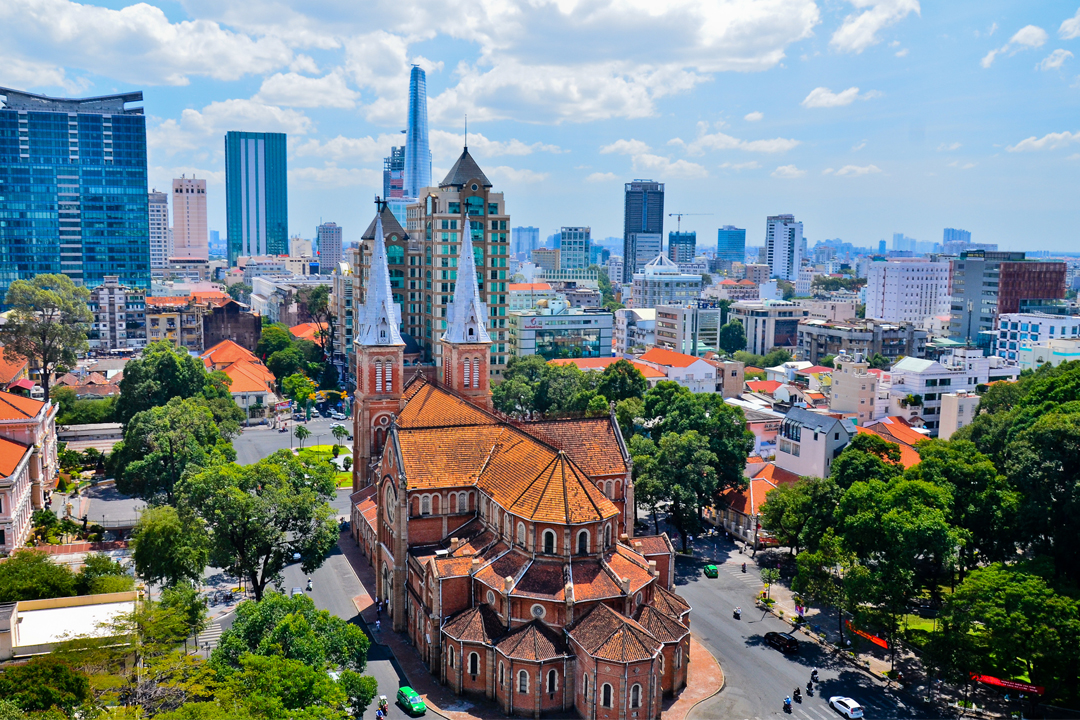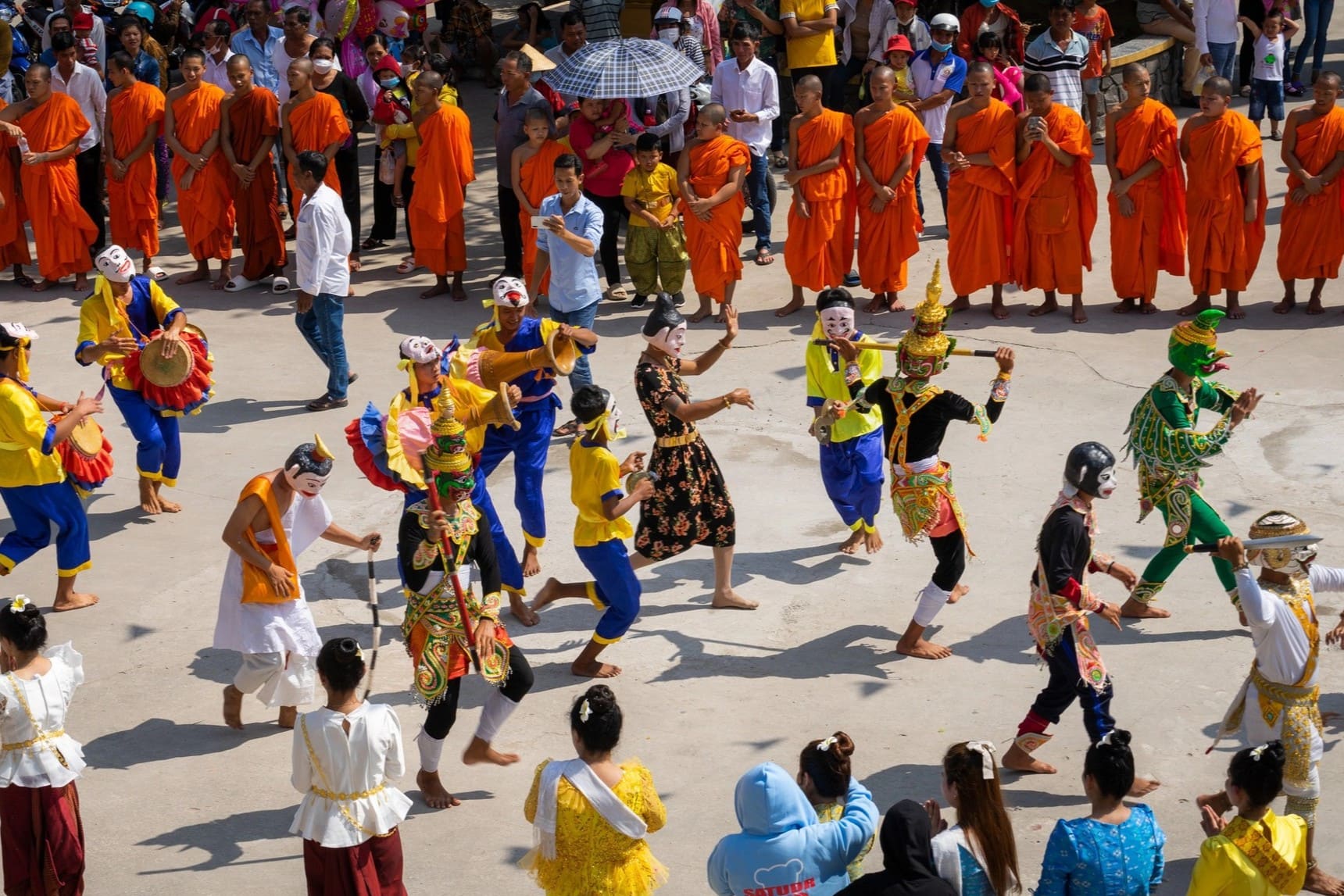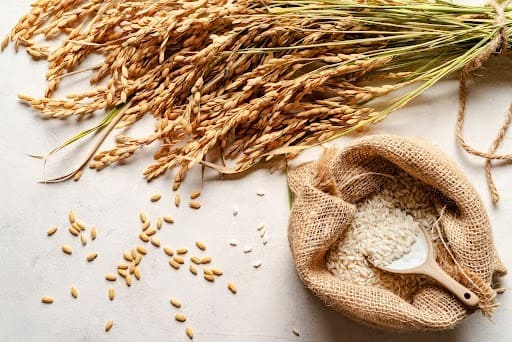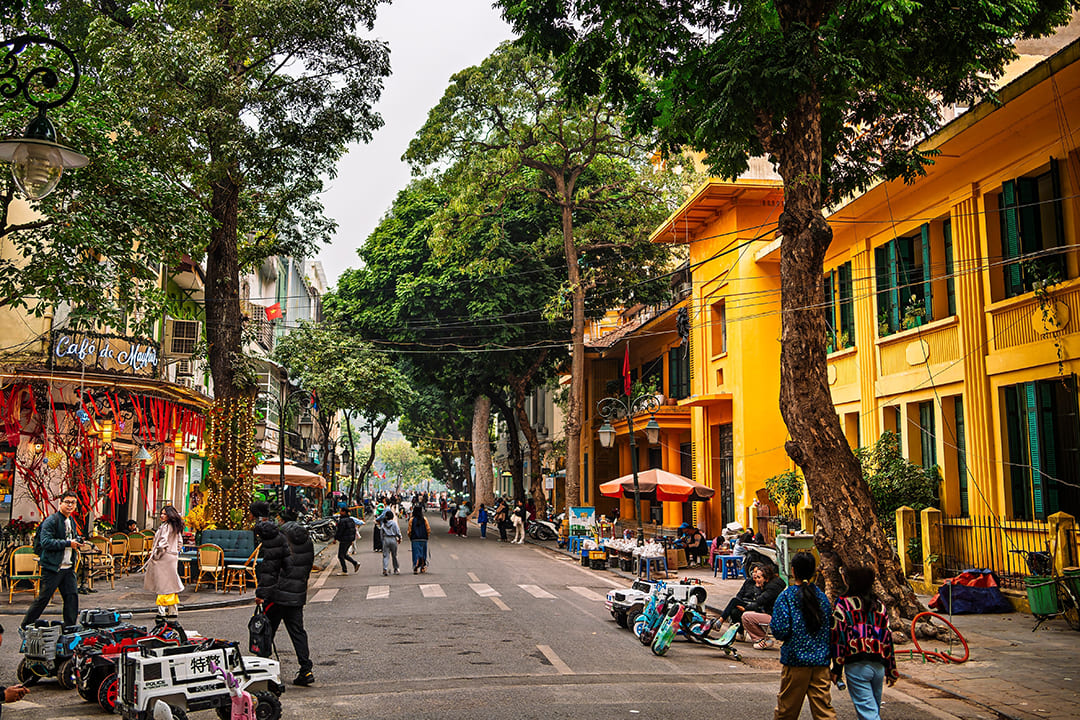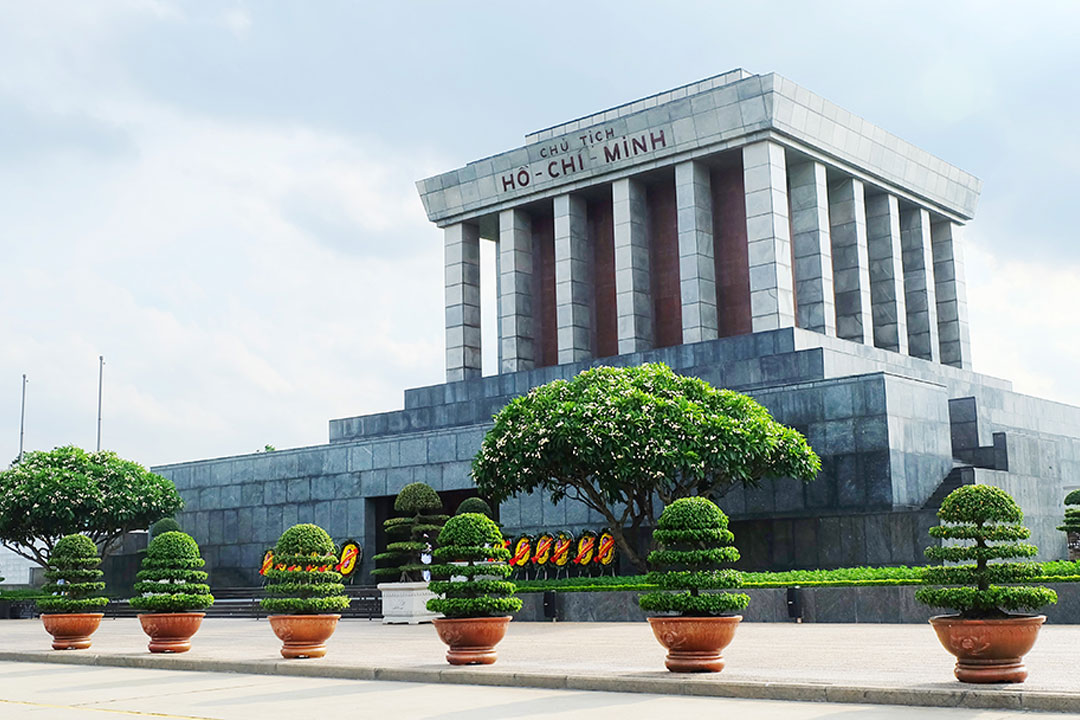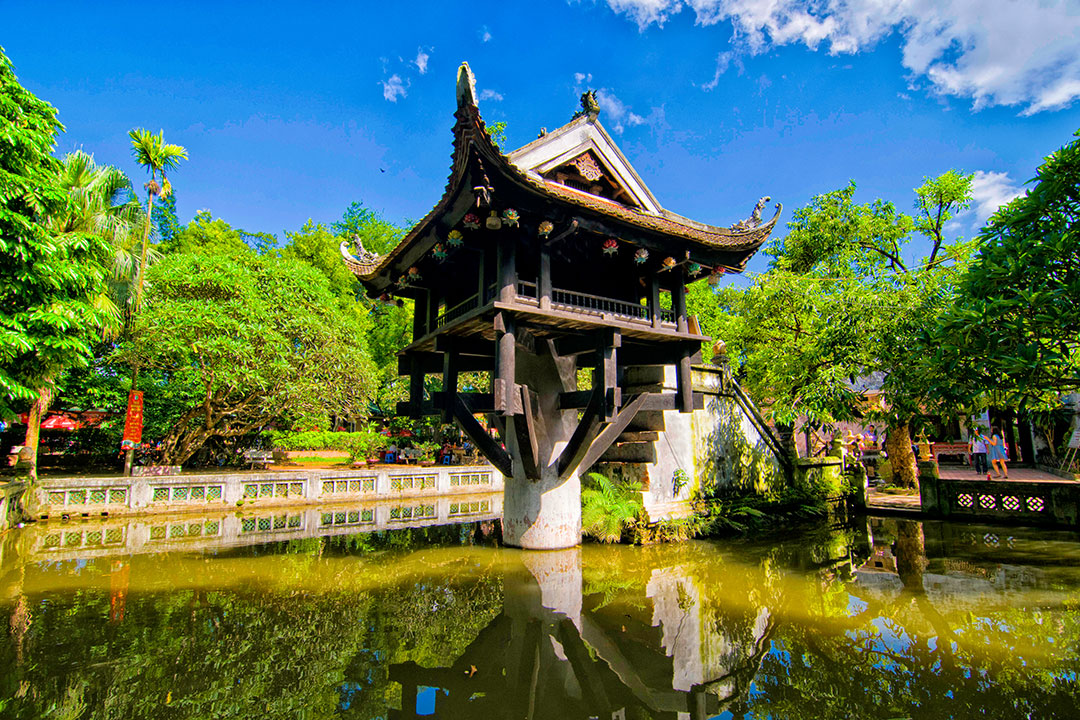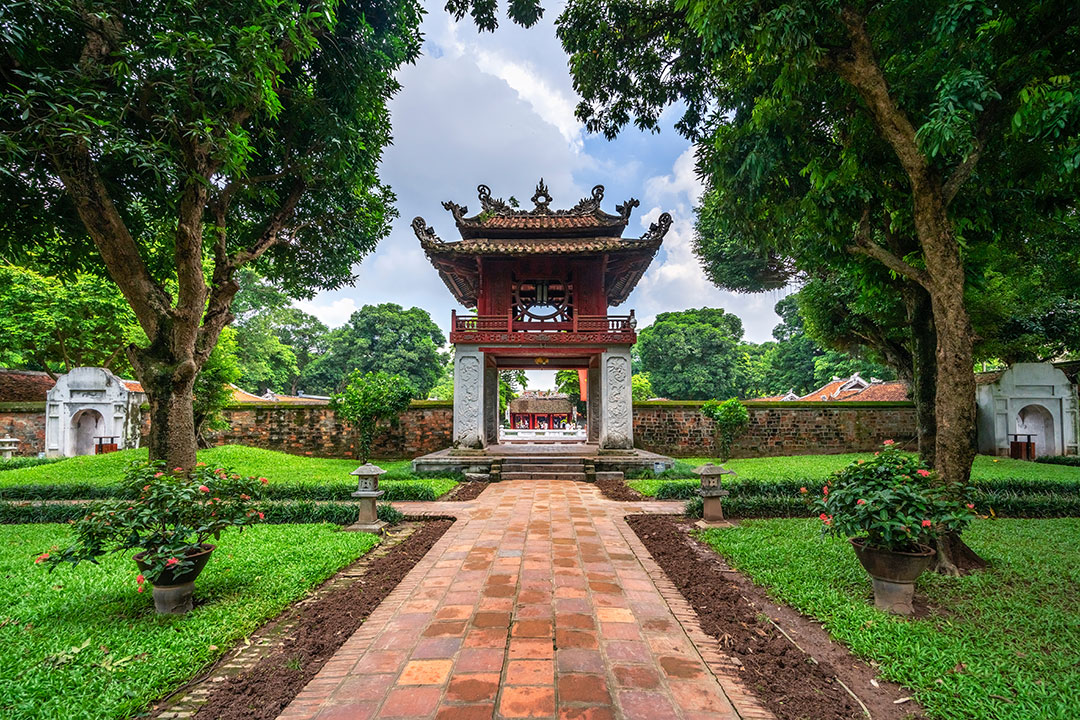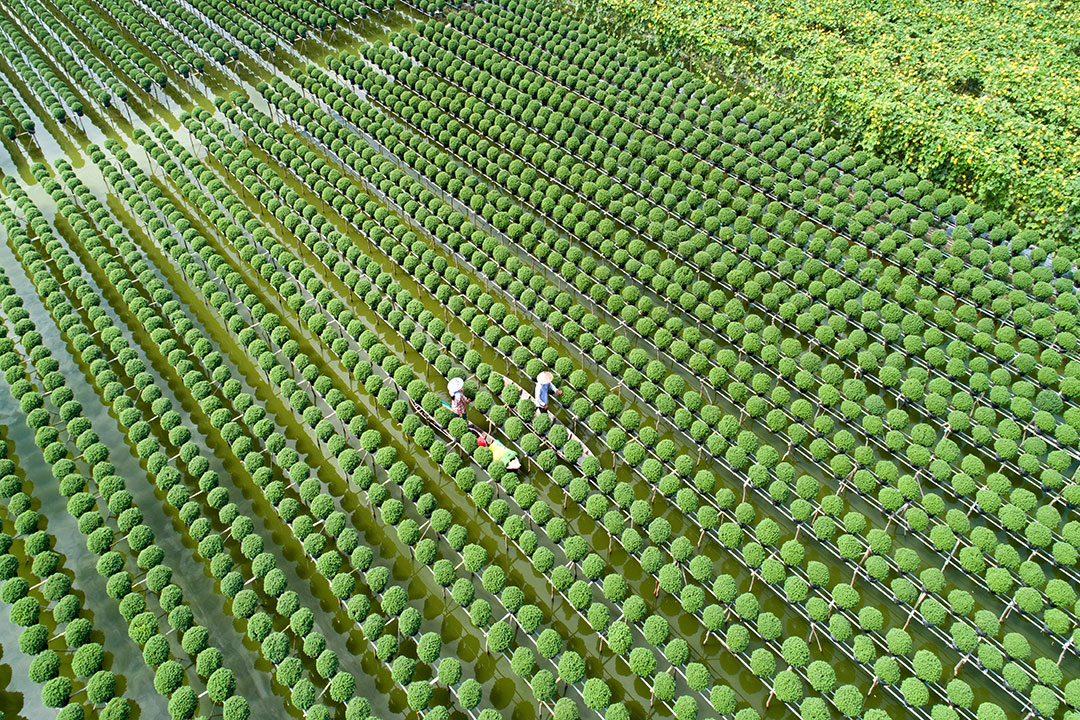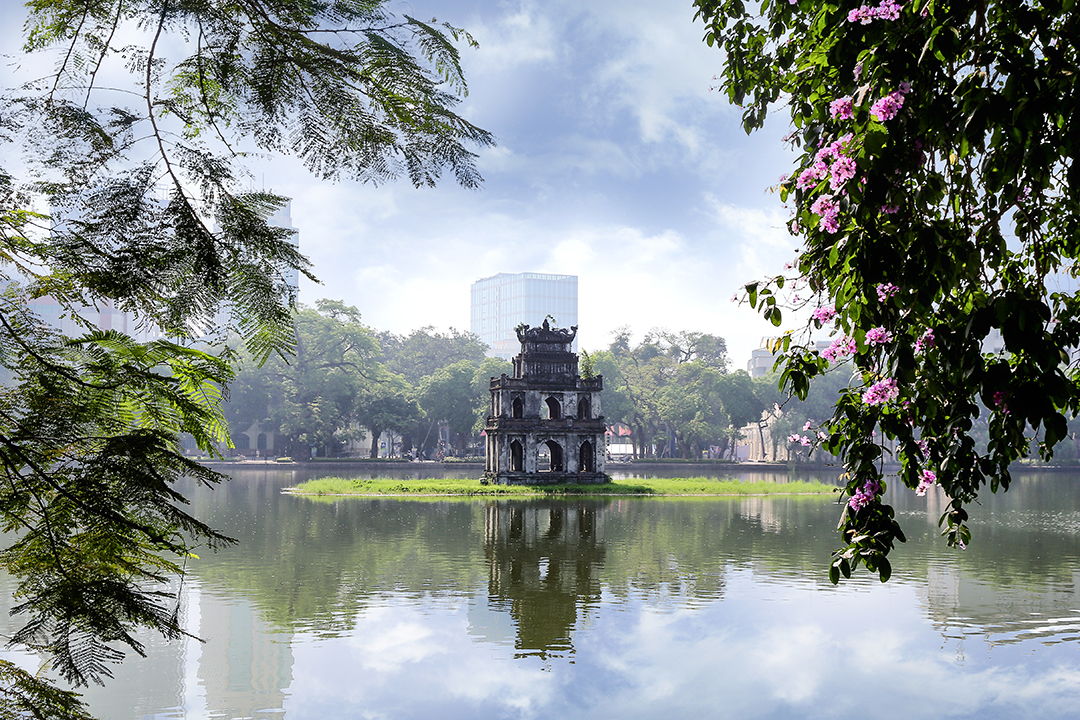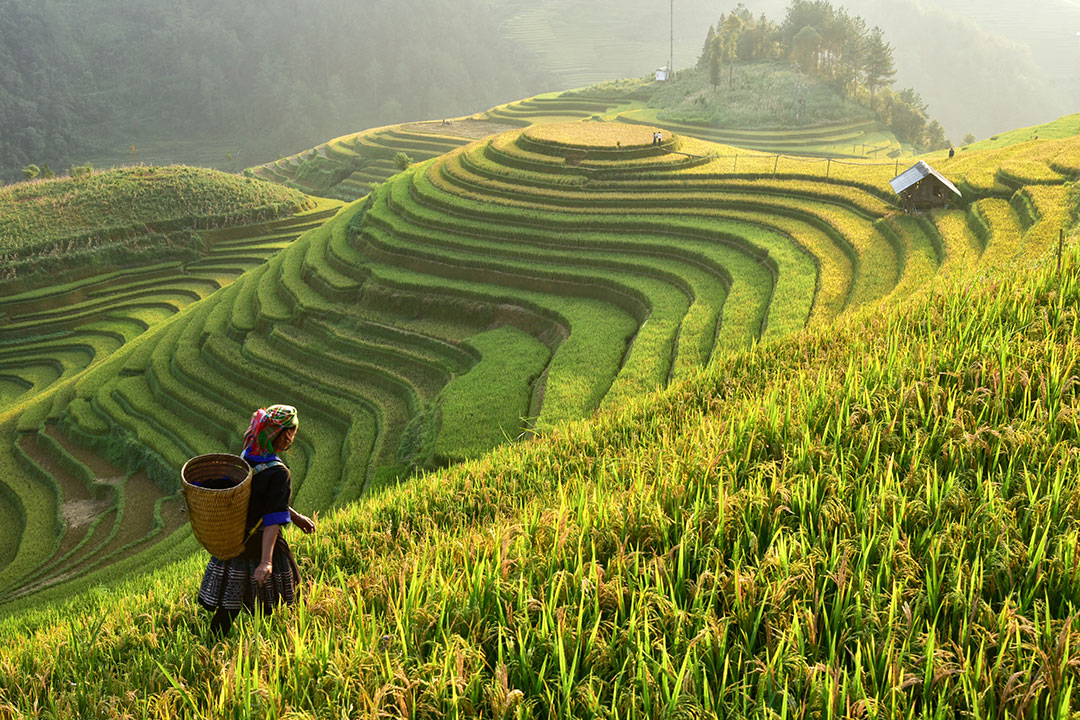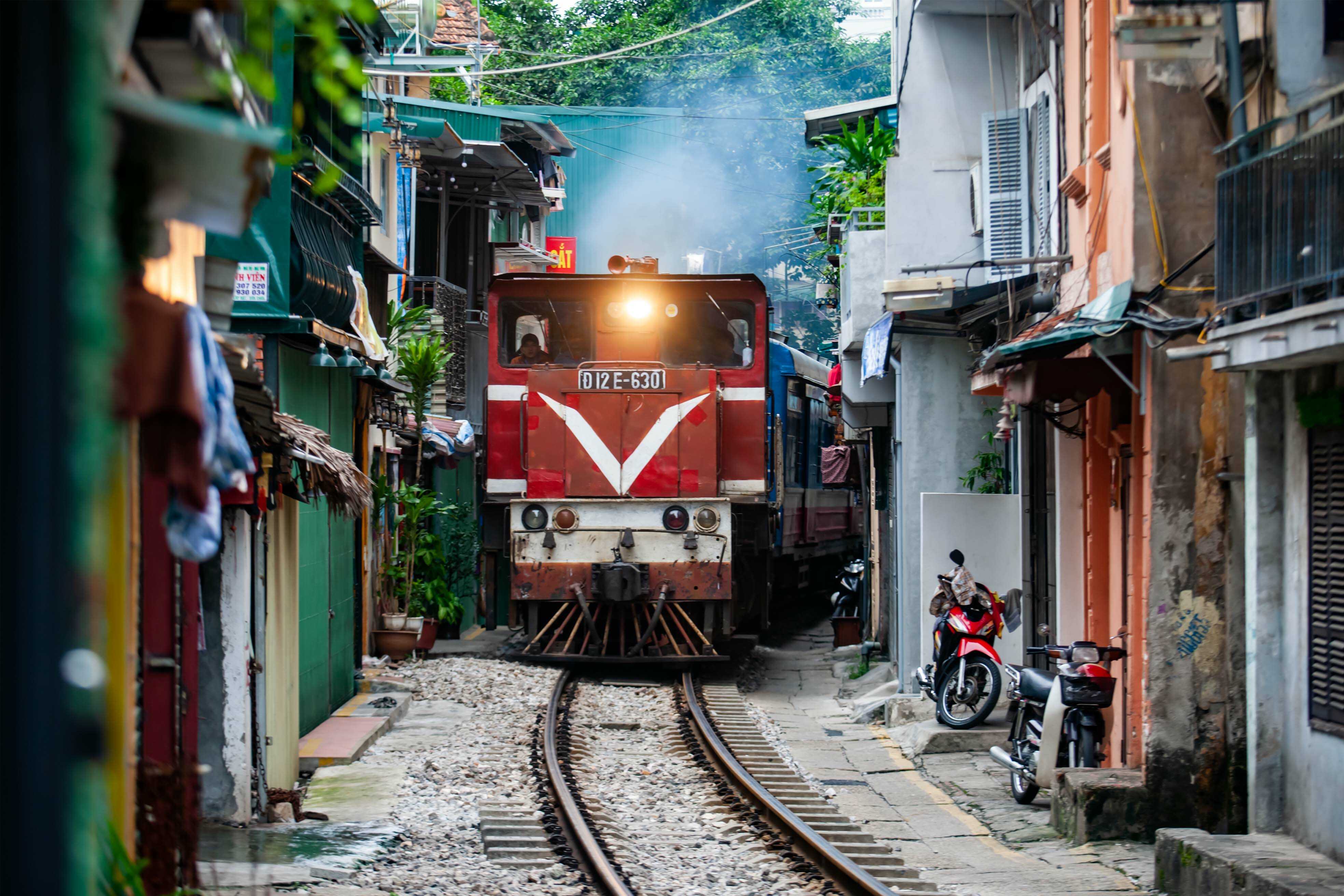Hanoi French Quarter: Overview, Features, Things To Do & Travel Guide
The Hanoi French Quarter is a fascinating blend of past and present, where colonial elegance meets vibrant local culture. Known for its broad boulevards lined with majestic buildings and hidden courtyards, this area offers more than just a glimpse into the architectural prowess brought by the French during their time in Vietnam.
For travelers seeking to immerse themselves in rich history while savoring contemporary Vietnamese life, the Hanoi French Quarter provides a captivating backdrop. This enticing neighborhood isn't just an echo of bygone times but also a thriving hub that harmoniously integrates modernity with heritage. In this article, GTrip delves deeper into why this age-old district continues to be a magnet for tourists and how it encapsulates the timeless charm Hanoi is renowned for.
Where is Hanoi French Quarter
Hanoi French Quarter is located in the southeastern part of Hanoi’s city center, adjacent to the famous Hoan Kiem Lake. This area is primarily situated within the former Hoan Kiem District, especially around the streets south and east of the lake, such as Trang Tien, Phan Chu Trinh, Ly Thuong Kiet, and Hai Ba Trung streets.
The French Quarter is known for its wide, tree-lined boulevards, grand colonial-era buildings, embassies, luxury hotels, and cultural landmarks, including the Hanoi Opera House. It stands in contrast to the narrow, bustling streets of the nearby Old Quarter, offering a more spacious and architecturally elegant atmosphere reminiscent of French influence from the colonial period
History of Hanoi French Quarter
The transformation of this area began in earnest during the tenure of Governor-General Paul Doumer (1897-1902), whose ambitious urban planning initiatives dramatically reshaped Hanoi's cityscape. Under his direction, extensive swamplands were drained to create habitable space. The implementation of wide, airy thoroughfares like Trang Tien, Ly Thuong Kiet, and Hai Ba Trung streets brought a distinctly European urban design to Southeast Asia. These development efforts reflected France's determination to create a prestigious colonial showcase that would serve as the administrative and political hub for its Indochinese territories.
The Hanoi French Quarter was meticulously designed as a "miniature Paris" in the East. It features impressive governmental buildings and residential structures that embody various European architectural styles. Walking through the district today, you can observe the harmonious blend of French neoclassical elements, Art Deco influences, and Gothic Revival characteristics that define the area's visual identity. Notable among these are the Opera House, the former Residence of the Governor-General (now the Government Guest House), and numerous diplomatic missions housed in colonial-era villas.
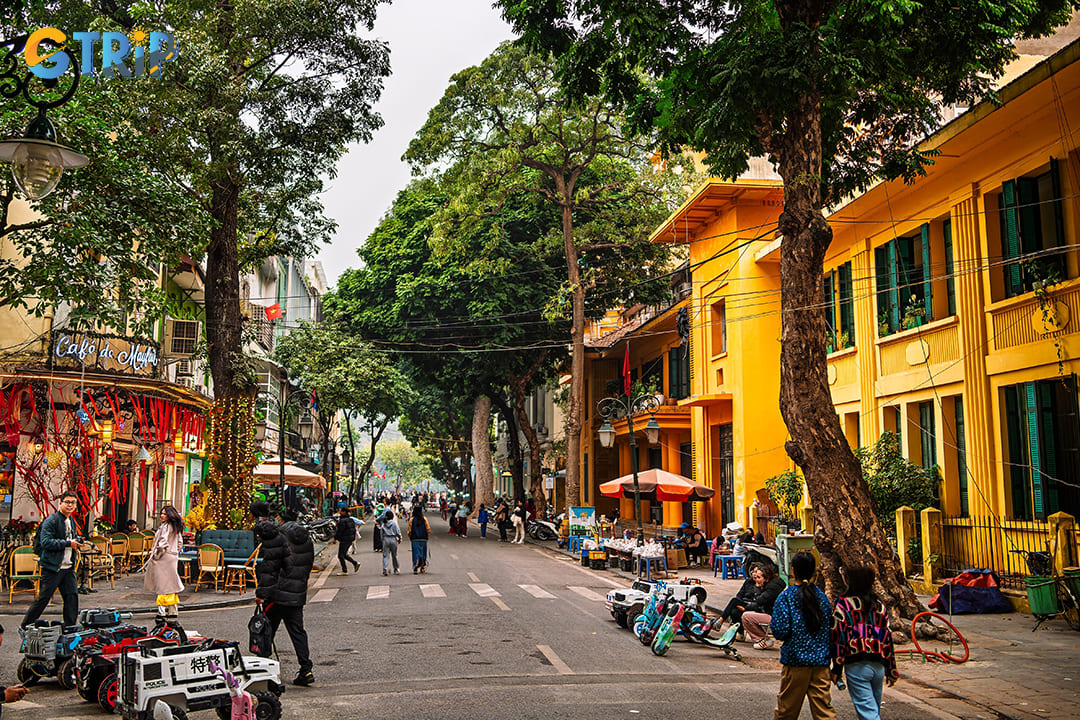
Nestled southeast of Hoan Kiem Lake in the heart of Hanoi, the Hanoi French Quarter stands as an elegant testament to Vietnam's colonial past
Beyond its architectural significance, the French Quarter witnessed pivotal moments in Vietnam's complex journey toward independence. These elegant streets and buildings served as silent witnesses to colonial rule, Japanese occupation during World War II, and the eventual Vietnamese revolution. This layered history adds profound depth to what might otherwise be appreciated solely for its aesthetic qualities. This makes the French Quarter an architectural museum and also a living historical document where French colonial ambitions met Vietnamese resilience and cultural identity. Today, the district is one of Hanoi's most captivating areas, blending European architecture with Vietnamese culture.
Distinctive features of the French Quarter
Walking through Hanoi's French Quarter feels like stepping into a different world compared to the bustling Old Quarter nearby. This elegant district showcases the unmistakable imprint of French colonial influence, creating a distinctive architectural landscape that sets it apart from the rest of Hanoi. The area's wide, tree-lined boulevards provide a stark contrast to the narrow, labyrinthine streets found elsewhere in the city.
The most recognizable characteristic of the French Quarter is its signature yellow-painted buildings with their distinctive red tile roofs and green shutters. This color palette creates a warm, inviting atmosphere that photographers find irresistible, especially during the golden hours of early morning or late afternoon. These colors weren't chosen arbitrarily; yellow symbolized royalty in Vietnamese culture, while the French appreciated its elegant appearance against the tropical backdrop.
Strolling down streets like Trang Tien or Ly Thai To reveals the Parisian street style that defines the district. Broad sidewalks lined with tall trees create dappled shade perfect for leisurely walks, while ornate street lamps add to the European ambiance. Many buildings feature elegant wrought iron balconies that extend outward, adorned with intricate patterns that showcase the craftsmanship of a bygone era.
The architectural styles throughout the French Quarter reflect diverse European influences adapted to Vietnam's tropical climate:
- Neoclassical: Characterized by symmetrical arrangements, columns, and triangular pediments, most notably seen in the Opera House
- Art Deco: Distinguished by bold geometric patterns, vibrant colors, and stylized ornamental elements
- Indochine: A unique fusion style combining French design principles with adaptations for Vietnam's climate (high ceilings, large windows)
- Gothic: Featuring pointed arches and flying buttresses, primarily found in religious structures like St. Joseph's Cathedral
The ornate facades throughout the district display decorative elements including intricate moldings, sculptures, and detailed cornices. These architectural flourishes create visual interest at every turn, rewarding careful observation with delightful discoveries of hidden details and artistic embellishments.
What truly defines the French Quarter's character is its successful blend of Western lifestyle with Vietnamese culture. French bakeries share streets with traditional Vietnamese coffee shops, and colonial-era government buildings stand near local markets. This harmonious cultural fusion creates an atmosphere unlike anywhere else in Vietnam, where East meets West in an elegant, architectural dialogue that continues to captivate tourists today.
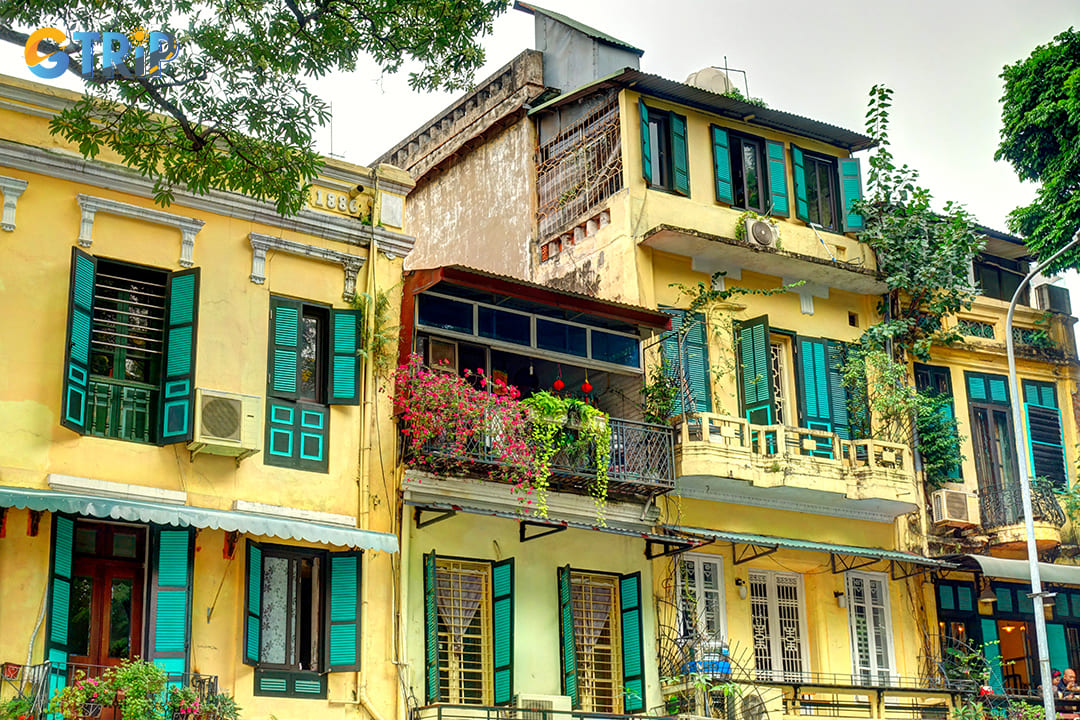
The most recognizable characteristic of the French Quarter is its signature yellow-painted buildings with their distinctive red tile roofs and green shutters
8 things to do in Hanoi French Quarter
The French Quarter in Hanoi offers tourists a perfect blend of colonial charm and Vietnamese culture, with many activities. This historic district presents countless opportunities for travelers to immerse themselves in both Vietnam's rich heritage and French influences. Here's a comprehensive guide to the top activities and experiences waiting for you in this captivating neighborhood.
1. Admire the stunning French colonial architecture
The French Quarter's most distinctive feature is undoubtedly its magnificent colonial architecture, which stands as a living museum of Vietnam's complex history. These elegant structures showcase a fascinating fusion of European design principles adapted to Vietnam's tropical climate.
The Hanoi Opera House, completed in 1911, stands as the crown jewel of French architecture in the city. Modeled after the Palais Garnier in Paris, this neoclassical masterpiece features ornate detailing, grand staircases, and a stunning facade that's particularly photogenic when illuminated at night. Just a short walk away, St. Joseph's Cathedral presents a striking example of Gothic Revival architecture with its twin bell towers and stained glass windows imported from France.
For a more sobering yet historically significant experience, visit Hoa Lo Prison (nicknamed the "Hanoi Hilton" by American POWs during the Vietnam War). While only a portion of the original French colonial prison remains, its yellow walls and imposing gates offer insight into both the French colonial period and the Vietnam War. The architecture itself reveals French penal design philosophy adapted to tropical conditions.
Notable French Colonial buildings to visit:
- Hanoi Opera House: Neoclassical grandeur, guided tours available on non-performance days
- St. Joseph's Cathedral: Gothic Revival masterpiece with daily mass services
- Hoa Lo Prison Museum: Historical prison with exhibitions on colonial-era incarceration
- Presidential Palace: Yellow mansion serving as the official residence of Vietnam's president
- National Museum of Vietnamese History: Housed in a former French school of Asian studies
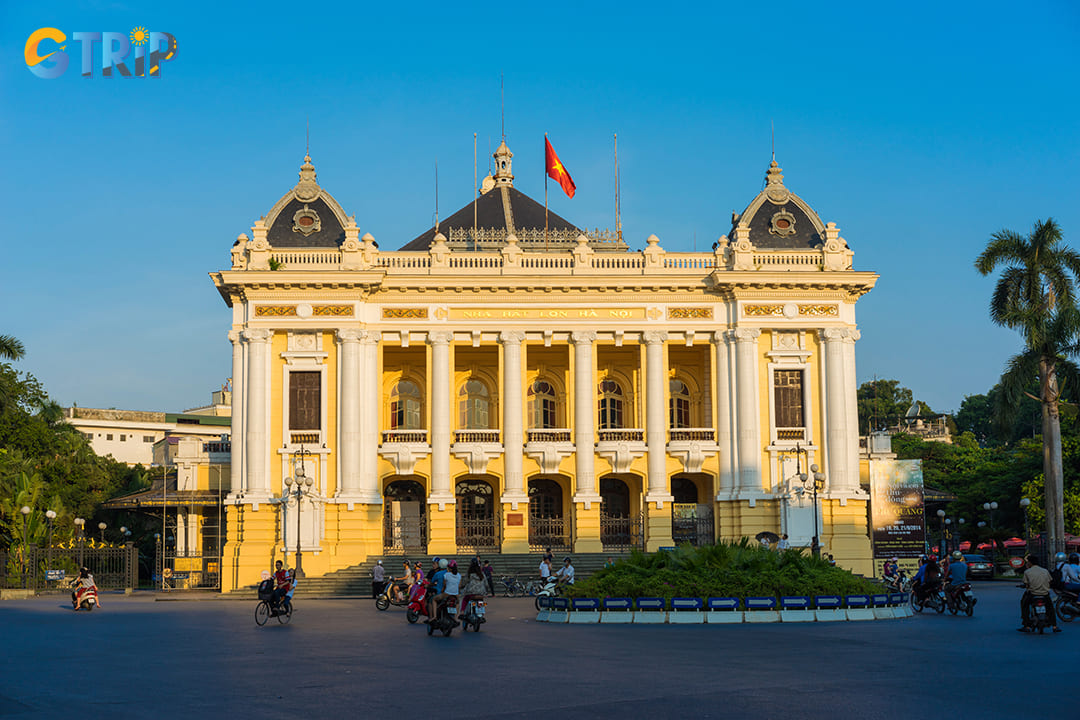
The Hanoi Opera House, completed in 1911, stands as the crown jewel of French architecture in the city
2. Immerse yourself in the vibrant art scene
The French Quarter has evolved into Hanoi's premier arts district. This is where traditional Vietnamese aesthetics blend with contemporary influences in a thriving creative ecosystem. Discover local talent at the Vietnam Fine Arts Museum, housed in a colonial-era building that was once a Catholic girls' school. The museum showcases everything from ancient folk art to revolutionary propaganda and contemporary paintings across 20+ exhibition rooms. For cutting-edge contemporary works, visit Manzi Art Space, a colonial villa transformed into an independent art gallery and cafe that regularly hosts exhibitions, film screenings, and artist talks.
The district's artistic spirit extends beyond formal galleries onto its very streets. Take a leisurely stroll along Trang Tien Street to discover outdoor installations and temporary exhibitions. The area around Ly Thuong Kiet Street has become known for its street murals, where young Vietnamese artists create bold works that often blend traditional motifs with modern urban aesthetics.
3. Capturing many stunning photos at the French Quarter
The French Quarter presents endless opportunities for photography enthusiasts with its picturesque blend of architectural grandeur, tree-lined boulevards, and vibrant street life. The most photogenic spots include the Opera House square, especially at sunrise when golden light bathes its yellow facade, creating a warm glow against the blue morning sky. The wide boulevards like Trang Tien and Dien Bien Phu offer perfect symmetrical compositions framed by leafy trees and colonial buildings. For street photography, the intersection of Trang Tien and Hang Bai streets captures the fascinating contrast between French architecture and the dynamic pace of modern Vietnamese life.
Seasonal changes bring different photographic opportunities to the French Quarter. Visit during April-May when the district's numerous flamboyant trees burst into bright orange blooms, creating stunning foreground elements against colonial backgrounds. During the rainy season (July-August), the wet streets reflect the historic buildings, creating mirror-like effects perfect for atmospheric photography.
Photography tips for the French Quarter:
- Golden hour magic: Arrive at the Opera House area around 5:30-6:30 AM for the softest light
- Rainy day reflections: After rainfall, capture the puddle reflections of colonial buildings
- Architectural details: Use telephoto lenses to isolate ornate details on building facades
- Street life contrast: Frame modern Vietnamese street vendors against historic buildings
- Elevated perspectives: Visit rooftop cafes for unique aerial views of the district's layout
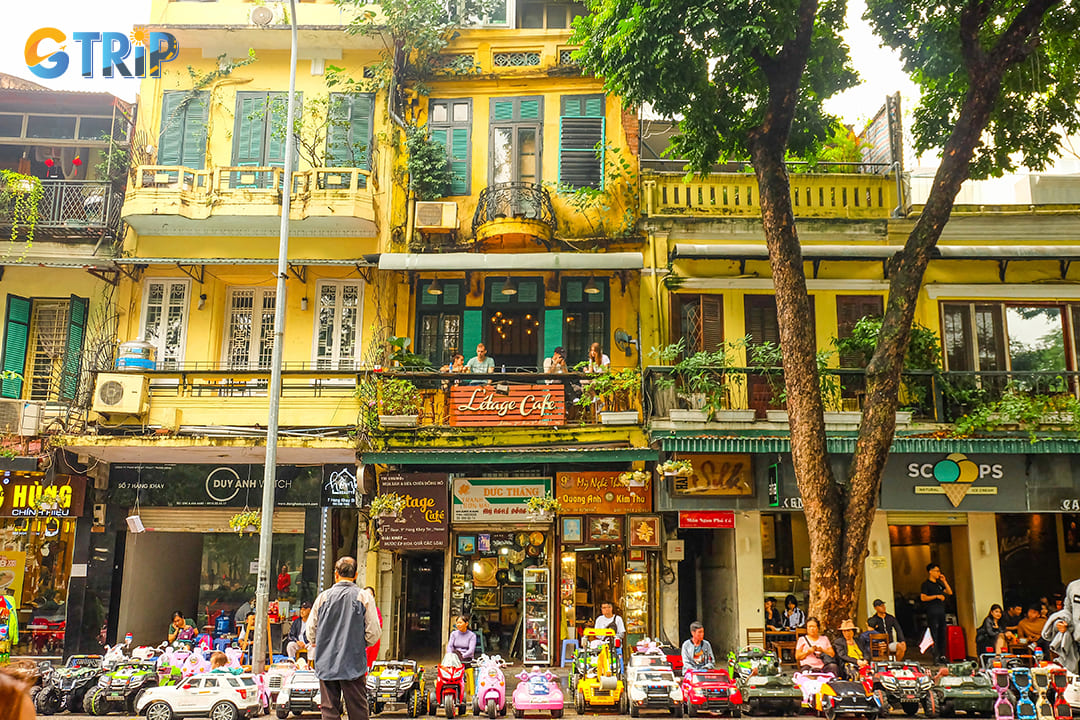
The French Quarter presents endless opportunities for photography enthusiasts with its picturesque blend of architectural grandeur, tree-lined boulevards, and vibrant street life
4. Relax in leafy parks and public spaces
The French Quarter features peaceful green spaces with European design and Vietnamese touches, offering a break from Hanoi's bustle. Lenin Park (officially Lenin Monument and Park) represents one of the district's largest green spaces, featuring manicured gardens surrounding a statue of Vladimir Lenin. Early mornings bring locals practicing tai chi and aerobics, while evenings see families strolling along its peaceful walkways. The park's central fountain creates a cooling microclimate during hot summer days, making it a favorite relaxation spot for both tourists and locals.
Indira Gandhi Park provides a more intimate experience with its ornamental trees and carefully planned flower beds. This pocket park exemplifies the European-style garden planning implemented during colonial times, with symmetrical pathways and sculpted vegetation. The small lake at its center attracts birdlife uncommon elsewhere in the city.
Best parks in the French Quarter:
- Lenin Park: Largest green space, best for morning exercise or evening strolls
- Indira Gandhi Park: Intimate garden setting with ornamental plantings
- Ly Thai To Garden: A Historic square with a statue of the city's founder
- August Revolution Square: Open space for public gatherings and performances
- Opera House Square: Not strictly a park, but it offers benches and people-watching
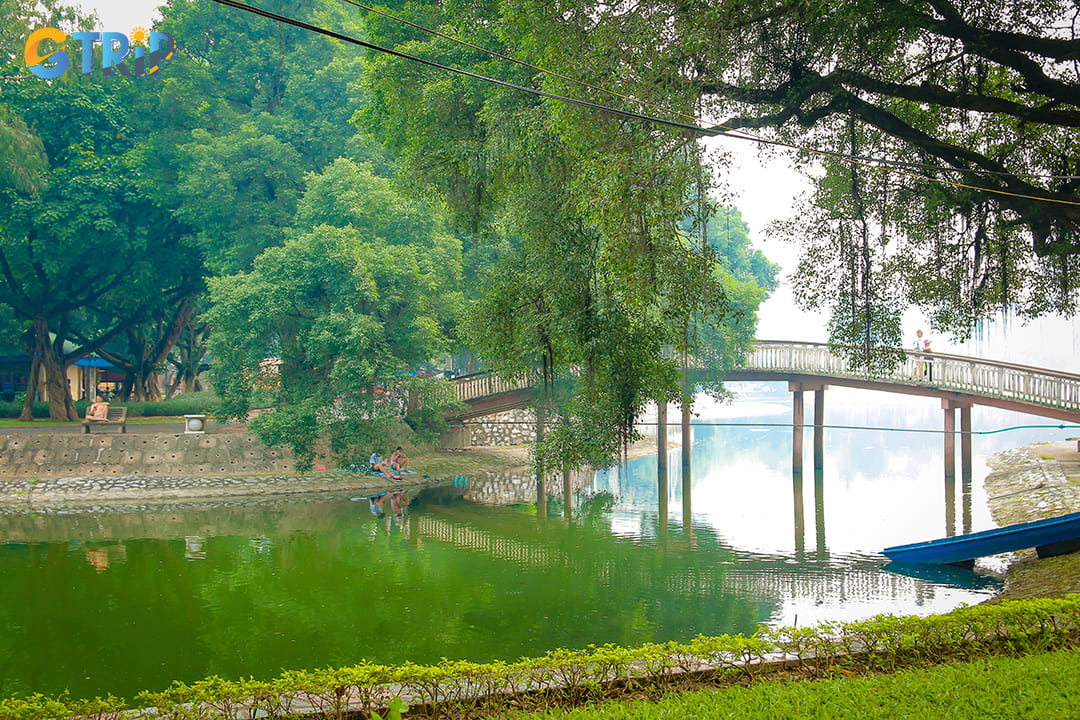
The French Quarter features peaceful green spaces with European design and Vietnamese touches, offering a break from Hanoi's bustle
5. Visit the museums
The French Quarter houses several of Hanoi's most significant museums, each offering unique insights into Vietnam's rich cultural heritage and complex history. The Vietnam National Museum of History occupies two magnificent French colonial buildings connected by an underground passage. Its comprehensive collection spans from prehistoric times through imperial dynasties to the modern era. It features over 200,000 artifacts, including the remarkable Dong Son bronze drums (dating from 500 BCE). The museum's architecture itself tells a story, with the original building constructed in 1932 as the Ecole Francaise d'Extreme-Orient, showcasing Indochinese architectural elements.
The Vietnamese Women's Museum provides a fascinating perspective on the country's social history through the experiences of its women. Housed in a modern building, its well-curated exhibitions explore women's roles in family life, traditional crafts, fashion, and notably, their significant contributions during Vietnam's revolutionary struggles. The marriage customs exhibit offers particular insight into Vietnam's ethnic diversity through its display of traditional wedding practices.
The Vietnam Museum of Revolution chronicles the country's struggles for independence, from resistance against French colonialism to the American War. Located in a former French ministry building, its exhibitions feature evocative photographs, weapons, and personal items from revolutionary leaders.
Museum highlights table:
| Museum | Focus | Must-see exhibits | Recommended time |
|---|---|---|---|
| National Museum of History | Comprehensive history | Dong Son bronze drums, imperial artifacts | 2-3 hours |
| Vietnamese Women's Museum | Women's roles, culture | War contribution gallery, fashion collection | 1.5-2 hours |
| Museum of Revolution | Independence struggles | Ho Chi Minh artifacts, war memorabilia | 1-2 hours |
| Hoa Lo Prison Museum | Colonial oppression, POW history | Guillotine room, John McCain's flight suit | 1 hour |
| Fine Arts Museum | Vietnamese art through the ages | Folk paintings, revolutionary propaganda art | 1.5-2 hours |
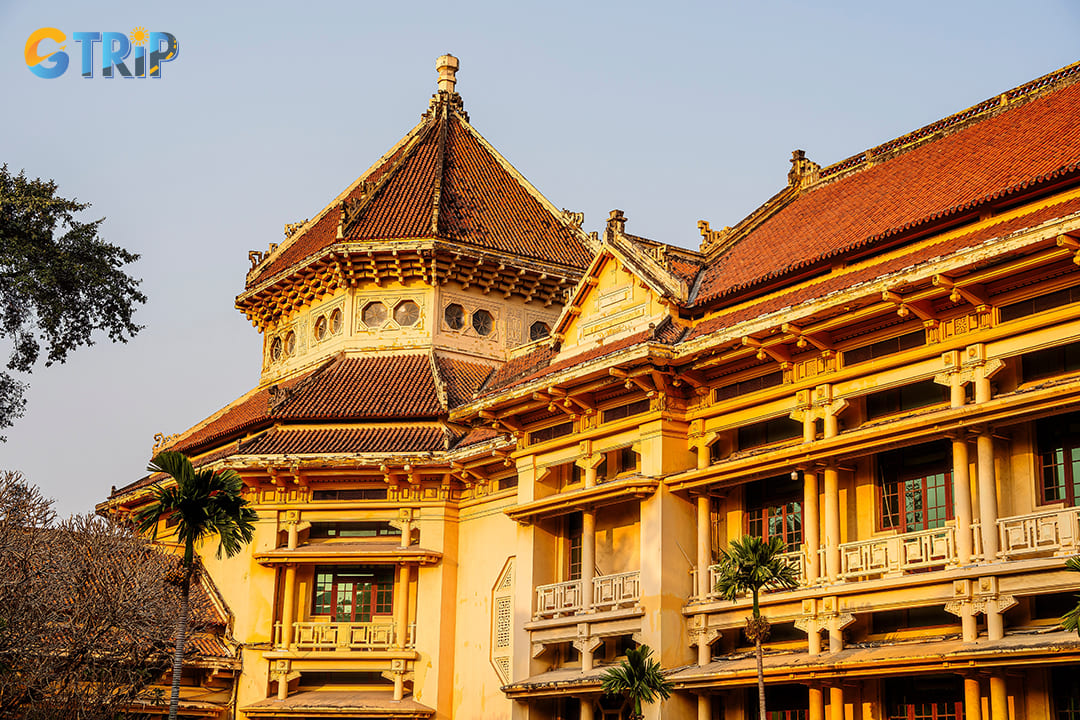
The French Quarter houses several of Hanoi's most significant museums, each offering unique insights into Vietnam's rich cultural heritage and complex history
6. Enjoy upscale dining and cafe culture
The French Quarter presents a remarkable fusion of Vietnamese and French culinary traditions, creating a distinctive food scene that reflects the district's unique cultural heritage. Traditional Vietnamese cuisine receives elegant treatment at renowned establishments like Bun Cha Huong Lien (made famous by Anthony Bourdain and President Obama's visit). Their signature dish, bun cha, features grilled pork patties and slices served with rice noodles, fresh herbs, and dipping sauce, epitomizing northern Vietnamese flavors in a simple yet sophisticated preparation. For upscale Vietnamese dining, Home Hanoi Restaurant offers refined local dishes in a colonial villa atmosphere.
The district's French culinary influence shines through its patisseries and boulangeries. At S'Patisserie, enjoy delicate opera cakes, croissants, and macarons with views over Hoan Kiem Lake. For a more substantial French meal, La Badiane serves contemporary French cuisine with Vietnamese accents in a colonial villa setting, featuring dishes like duck confit with local herbs or creme brulee infused with Saigon cinnamon.
Coffee culture thrives along Trieu Viet Vuong Street, known as "Coffee Street" to locals. Traditional Vietnamese cafes like Cafe Giang serve the iconic egg coffee, a Hanoi specialty created during French colonial times when milk was scarce. Culinary experiences in the French Quarter:
- Traditional Vietnamese: Bun Cha Huong Lien, Home Hanoi Restaurant, Quan An Ngon
- French-Vietnamese Fusion: La Badiane, Le Beaulieu
- Cafes & Patisseries: Cafe Giang, S'Patisserie, The Note Coffee
- Street Food: Banh Mi 25, Bun Bo Nam Bo, Pho Thin
-1749536331AZsDo.jpg)
Traditional Vietnamese cuisine receives elegant treatment at renowned establishments like Bun Cha Huong Lien
7. Shop at boutique stores and local markets
The French Quarter offers a sophisticated shopping experience that ranges from luxury international brands to unique locally-made products, all within architecturally significant settings. Trang Tien Plaza stands as the district's premier luxury shopping destination, housed in a renovated colonial-era department store building. Inside, you'll find international fashion houses like Louis Vuitton and Dior alongside high-end Vietnamese designer boutiques. The plaza's central atrium features regular cultural exhibitions and performances, making shopping here a cultural experience in itself.
For more authentic Vietnamese crafts and souvenirs, the eastern edge of the French Quarter borders Hanoi's Old Quarter. This is where the historic Dong Xuan Market offers four floors of merchandise ranging from textiles and clothing to handicrafts and food products. The nearby night market on Hang Dao Street (operating Friday through Sunday evenings) transforms the street into a pedestrian-only shopping paradise with hundreds of vendors selling everything from lacquerware to contemporary fashion.
Boutique shopping thrives along Trang Tien and Hai Ba Trung streets, where colonial shophouses have been transformed into specialty stores. Stores like Tan My Design and Hanoia showcase high-quality Vietnamese craftsmanship with modern sensibilities. Shopping destinations by category:
| Type | Venue | Specialties |
|---|---|---|
| Luxury | Trang Tien Plaza | International brands, Vietnamese designer fashion |
| Traditional markets | Dong Xuan Market | Textiles, souvenirs, and everyday items |
| Night markets | Hang Dao Street | Street food, souvenirs, casual fashion |
| Artisanal boutiques | Tan My Design | Hand-embroidered linens, contemporary crafts |
| Specialty shops | Hanoia | Lacquerware, home decor |
| Bookstores | Bookworm | English books, maps, and Vietnamese literature |
-1749536338A12g0.jpg)
Trang Tien Plaza stands as the district's premier luxury shopping destination, housed in a renovated colonial-era department store building
8. Experience nightlife and cultural performances
As evening falls, the French Quarter shifts from a historical hub to a vibrant cultural and nightlife destination. The Hanoi Opera House anchors the district with ballet, classical concerts, and folk performances, advance booking is recommended, especially for international acts. St. Joseph’s Cathedral also offers occasional evening choirs, with Christmas Eve mass being a standout.
Nightlife options range from refined to relaxed. Enjoy cocktails and live jazz at the Press Club or Hotel Metropole’s Bamboo Bar, or sample local craft brews at Standing Bar. For creative cocktails, visit Ne Cocktail Bar or vintage-style Polite & Co. Nearby Hoan Kiem Lake comes alive with street performances on pedestrian-only weekends. With its glowing colonial facades and relaxed pace, the French Quarter offers an elegant contrast to the nearby Old Quarter, making it a must-visit after dark.
-1749536344nQk7f.jpg)
As evening falls, the French Quarter shifts from a historical hub to a vibrant cultural and nightlife destination
Best times to visit Hanoi's French Quarter during the day
To fully appreciate the French Quarter’s charm, plan your visit for early morning or late afternoon. Between 8:00 and 11:00 AM, the air is cool, the streets are quiet, and the soft light highlights the colonial architecture beautifully. It’s the perfect time for a peaceful walk or a slow coffee at local favorites. Late afternoon, from 4:00 to 6:30 PM, is another ideal window. As the sun sets, golden light warms the elegant facades and the streets fill with a relaxed, after-work energy. This is also a great time to enjoy happy hour at nearby bars or catch street performers near Ly Thai To Garden and Trang Tien Street.
The best months to visit are October to December, when the weather is mild and dry, and January to March, which tends to be cooler with fewer crowds. April offers spring colors and festive energy. From May to September, however, the heat and humidity can be intense, with frequent afternoon rains, so it’s best to explore early or in the evening.
-1749536348Br6TE.jpg)
To fully appreciate the French Quarter’s charm, plan your visit for early morning or late afternoon
How to get to Hanoi's French Quarter?
Navigating to Hanoi's French Quarter is straightforward with multiple transportation options available to suit different preferences and budgets. Here's a comprehensive guide to reaching this historic district with its tree-lined boulevards and colonial architecture.
By taxi or ride-hailing
Getting to the French Quarter via taxi or ride-hailing services provides the most direct and comfortable transportation option, especially for first-time visitors or those carrying luggage. If you're arriving at Noi Bai International Airport, the journey to the French Quarter takes approximately 23 minutes (without traffic) and costs between 400,000-500,000 VND ($17–22 USD). Popular ride-hailing apps operating in Hanoi include: Grab, Be, Xanh SM. For travelers already in Hanoi, short taxi rides within the city center typically range from 20,000 to 70,000 VND (0.85 - 3 USD) depending on distance and traffic conditions. Always ensure the driver uses the meter or agrees on a price beforehand to avoid overcharging.
By bus
Hanoi's public bus system offers an economical way to reach the French Quarter, with several routes passing through or near the district's main attractions. Key bus routes to the French Quarter:
| Bus number | Route description | Nearest stop to the French Quarter |
|---|---|---|
| 09B | Hoan Kiem Lake - Giap Bat | 39 Ly Thuong Kiet |
| 08A | Long Bien - Thanh Tri | 58B Ba Trieu |
| 31 | Bac Co - Sai Dong | 29 Hang Bai |
| 36 | Giap Bat - Yen Phu | 39 Ly Thuong Kiet |
| 45 | Times City - Nguyen Trai | 58B Ba Trieu |
| 49 | Giang Vo - Gia Lam | 29 Hang Bai |
Bus fares are remarkably affordable, ranging from 7,000 to 10,000 VND (approximately $0.30 to $0.43) per journey. The buses run frequently between 5:00 AM and 10:00 PM daily, though be prepared for crowded conditions during rush hours (7:00-9:00 AM and 5:00-7:00 PM). For the most up-to-date information on bus routes and schedules, you can use the "Timbus" app or check the official Hanoi Public Transport website.
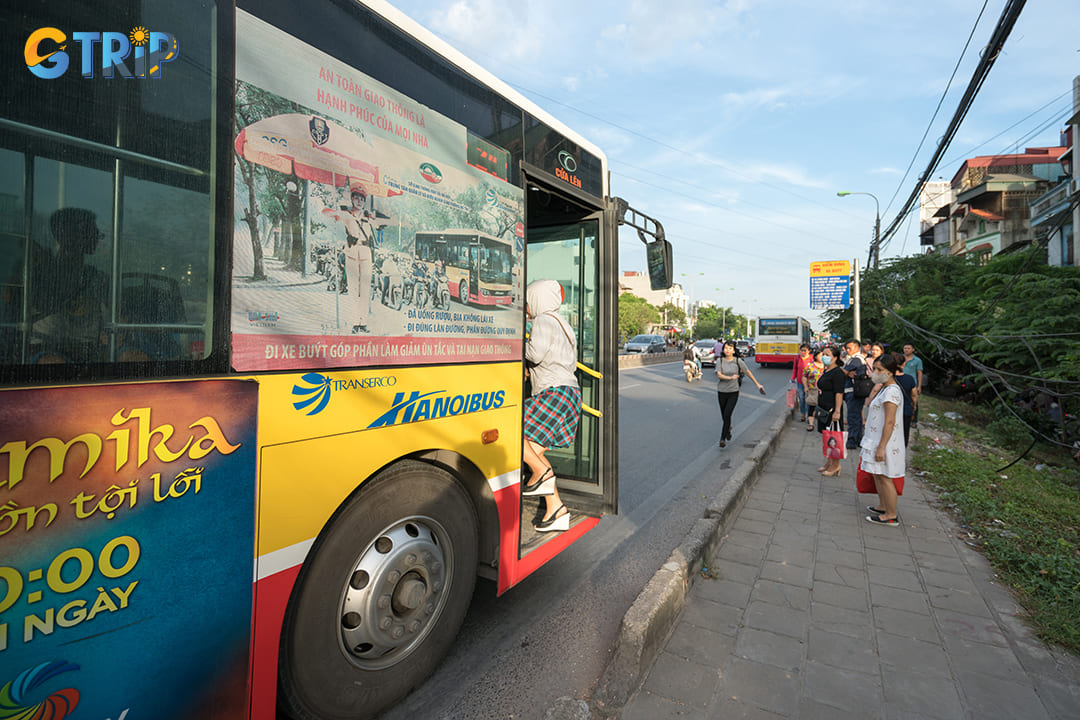
Hanoi's public bus system offers an economical way to reach the French Quarter
By motorbike or bicycle
Embracing Hanoi's local transportation culture with motorbikes or bicycles offers flexibility and an authentic experience when visiting the French Quarter. Motorbike rental services are abundant throughout Hanoi, with daily rates typically ranging from 130,000-200,000 VND (5.50 - 8.50 USD). Many accommodations can arrange rentals for guests. If you're not comfortable driving yourself, motorbike taxis (xe om) are readily available for shorter trips, costing between 20,000-40,000 VND (0.85 - 1.70 USD) for trips within central Hanoi.
Key considerations for motorbike transportation:
- International license requirements apply (though enforcement varies)
- Helmets are mandatory by law
- Traffic flows differently than in Western countries
- Navigation apps like Google Maps work well for directions
Bicycle rentals provide a more leisurely alternative for exploring the French Quarter, with several rental shops offering daily rates of 30,000-50,000 VND (1.30 - 2.15 USD). The flat terrain of central Hanoi makes cycling relatively easy, though be prepared to navigate alongside heavy traffic.
On foot
Walking is arguably the most immersive way to experience the French Quarter's architectural splendor and vibrant atmosphere. The district is compact and highly walkable, with most major attractions located within a 1-2 km radius. From Hoan Kiem Lake or the Old Quarter, you can comfortably walk to the French Quarter in 10-15 minutes. The tree-lined streets provide welcome shade during hot weather, making walking pleasant even during warmer months. Key walking routes include:
- From Hoan Kiem Lake: Head south along Trang Tien Street
- From the Old Quarter: Walk south along Hang Bai Street
- From Ba Dinh District: Head east along Phan Dinh Phung Street
Walking allows you to discover hidden cafes, boutique shops, and architectural details you might miss using other transportation methods. For safety, use designated crosswalks when available and be cautious of traffic when crossing streets.
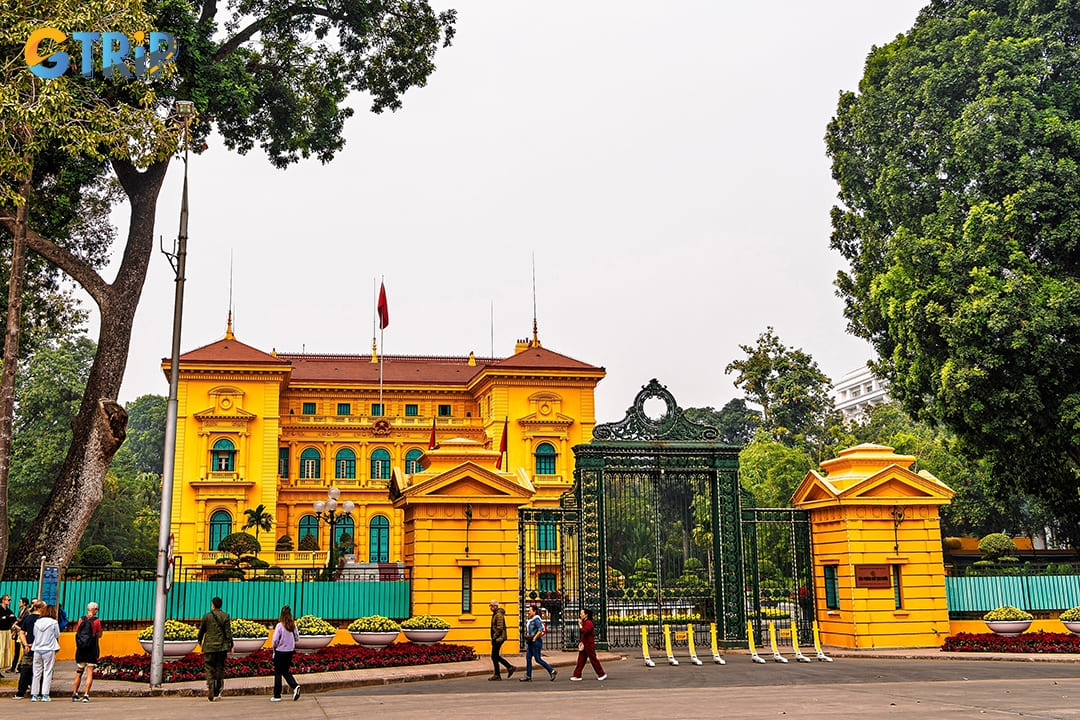
Walking is arguably the most immersive way to experience the French Quarter's architectural splendor and vibrant atmosphere
Where to stay in the French Quarter?
The French Quarter offers some of Hanoi's most elegant and historically significant accommodation options. Here are three exceptional properties that capture the essence of the quarter while providing world-class amenities and convenient access to major attractions.
Grand Cititel Hanoi Hotel
Nestled in the bustling Trang Tien area, the Grand Cititel Hanoi Hotel serves as an ideal base for exploring the French Quarter's historic landmarks and vibrant streets. This 4-star property seamlessly blends contemporary comfort with colonial-inspired design elements.
The Grand Cititel features spacious rooms with elegant decor, offering panoramic views of the city's distinctive skyline. What sets this property apart is its strategic location-merely a 5-minute walk from Hoan Kiem Lake and the iconic Hanoi Opera House. After a day of exploration, guests can unwind at the hotel's rooftop bar, which provides a breathtaking perspective of the quarter's architectural splendor.
Amenities and highlights:
- 24-hour concierge service with multilingual staff
- Rooftop dining with panoramic city views
- Complimentary walking tours of the French Quarter
- High-speed wifi throughout the property
- In-room spa services available upon request
Price range: $75-150 per night, depending on room category and season
Capella Hanoi
The Capella Hanoi represents the pinnacle of luxury accommodation in the French Quarter. Designed by celebrated architect Bill Bensley, this boutique hotel pays homage to the golden age of opera and the performing arts that once thrived in this neighborhood. Located just steps from the Hanoi Opera House, the hotel occupies a prime position on Le Phung Hieu Street.
Each of the 47 individually decorated rooms and suites tells a story, featuring curated artwork and memorabilia celebrating legendary opera performers and performances. The attention to detail is extraordinary, from hand-painted murals to custom furnishings that transport guests to the early 20th century while providing every modern luxury. The Capella's signature "Culturists" serve as personal concierges. It offers insider access to hidden gems throughout the French Quarter and tailoring experiences based on guests' interests.

The Capella Hanoi represents the pinnacle of luxury accommodation in the French Quarter
Minasi HanoiOI Lakeside Hotel
Situated on Ba Trieu Street, the Minasi HanoiOI LakeSide Hotel offers a more accessible price point without sacrificing location or comfort. This stylish mid-range hotel provides excellent value for travelers who want to experience the French Quarter's charm within a reasonable budget.
The property features clean, modern rooms with subtle Vietnamese design touches and all essential amenities. Many rooms offer views of nearby Hoan Kiem Lake, especially from the higher floors. The hotel's friendly staff are particularly knowledgeable about the neighborhood's history and can recommend lesser-known cafes, galleries, and architectural highlights within walking distance.
Why choose Minasi HanoiOI:
- Exceptional price-to-location value in the French Quarter
- Complimentary breakfast featuring both Western and Vietnamese options
- Walking distance to St. Joseph's Cathedral and the National Museum
- Bicycle rental service for exploring the wider neighborhood
- Quiet rooms despite the central location
For families or longer stays, the hotel's suite options provide additional space and kitchen facilities. It is particularly suitable for travelers seeking a home base for extended exploration of Hanoi's historic center.
Suggested itineraries for travelers
Exploring Hanoi's French Quarter requires thoughtful planning to fully appreciate its colonial charm and cultural significance. These carefully curated itineraries will help you experience the Quarter's historical landmarks, architectural gems, and local flavors at your own pace. These routes combine must-see attractions with hidden gems for an authentic taste of Hanoi's French-influenced district.
Half-day exploration of key sights
A half-day tour provides just enough time to witness the French Quarter's highlights while getting a taste of its unique atmosphere. This compact itinerary allows you to experience the district's colonial grandeur without feeling rushed.
Morning itinerary (8:00 AM - 12:30 PM)
Begin your exploration early to avoid the midday heat and crowds:
- 8:00 AM - 9:00 AM: Start with a traditional Vietnamese coffee at a cafe near Hoan Kiem Lake to fuel your adventure
- 9:00 AM - 10:00 AM: Visit the Opera House for photos and a glimpse of its magnificent architecture
- 10:00 AM - 11:00 AM: Walk to St. Joseph's Cathedral to admire its neo-Gothic design and serene atmosphere
- 11:00 AM - 12:00 PM: Explore the National Museum of Vietnamese History to understand the country's colonial past
- 12:00 PM - 12:30 PM: Conclude with lunch at a French-Vietnamese fusion restaurant like La Badiane or Green Tangerine
For those starting in the afternoon, adjust your schedule, but consider this essential route connecting the quarter's most significant landmarks:
| Time | Location | Highlight |
|---|---|---|
| 1:00 PM | Sofitel Metropole Hotel | Iconic colonial luxury hotel with guided historical tour |
| 2:00 PM | Trang Tien Plaza | Contemporary shopping in historic building |
| 3:00 PM | Opera House vicinity | Architecture photography and nearby cafes |
| 4:00 PM | St. Joseph's Cathedral | Religious landmark and surrounding boutiques |
| 5:30 PM | Dinner venue | French-Vietnamese cuisine to culminate experience |
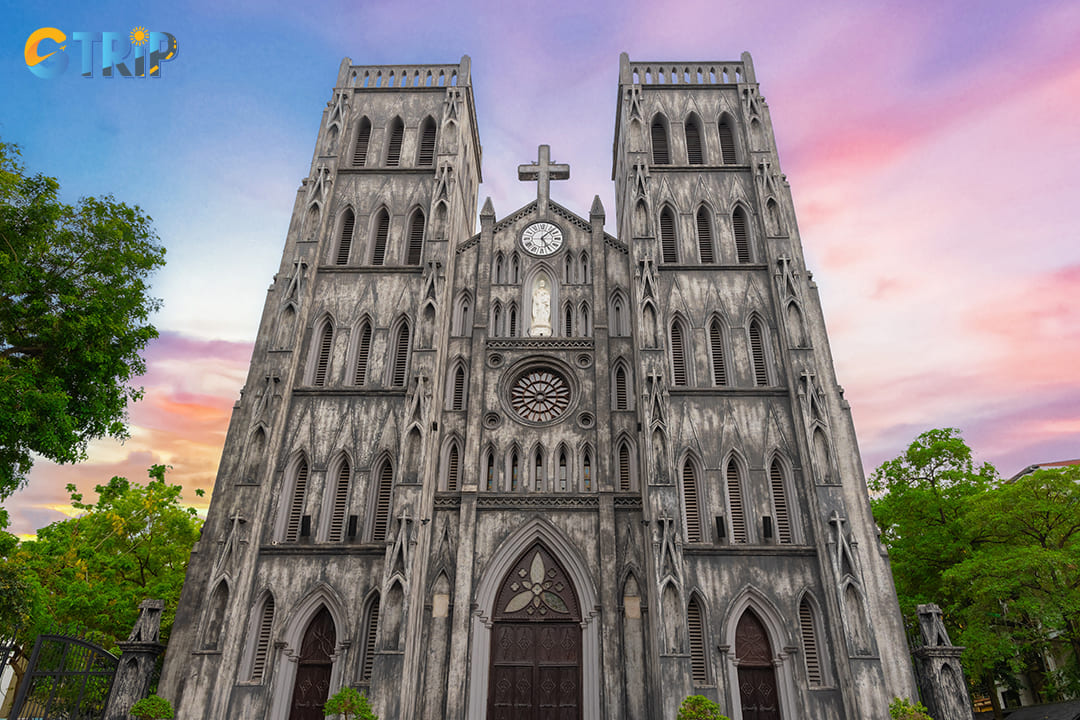
A half-day tour provides just enough time to witness the French Quarter's highlights while getting a taste of its unique atmosphere
Full-day immersion in the French Quarter
A full day allows for a deeper connection with the French Quarter. It combines major attractions with leisurely exploration of hidden corners, culinary experiences, and cultural activities.
Morning segment (8:00 AM - 12:00 PM)
- 8:00 AM: Begin with breakfast at a traditional cafe like Cafe Giang or a French patisserie
- 8:45 AM - 9:45 AM: Visit the Opera House when morning light creates perfect photography conditions
- 10:00 AM - 11:00 AM: Tour the Sofitel Metropole Hotel's historical wing and bomb shelter (book in advance)
- 11:15 AM - 12:00 PM: Explore the National Museum of Vietnamese History without rushing through exhibits
Afternoon segment (12:00 PM - 5:30 PM)
After a morning of historical sightseeing, transition to cultural and culinary experiences:
- Enjoy an extended lunch break (12:00 PM - 1:30 PM) at a colonial-era restaurant
- Visit St. Joseph's Cathedral and the surrounding boutique shops (1:30 PM - 3:00 PM)
- Take a leisurely walk down Trang Tien Street for shopping and ice cream (3:00 PM - 4:00 PM)
- Explore the hidden Art Deco buildings and architecture along Ly Thuong Kiet Street (4:00 PM - 5:30 PM)
Evening experience (5:30 PM onwards)
Complete your immersion with cultural entertainment:
- Attend a performance at the Opera House if available
- Enjoy dinner at a fine dining establishment like La Verticale or Press Club
- Finish with evening cocktails at the Metropole's Bamboo Bar for an authentic colonial ambiance

Begin your day with breakfast at a traditional cafe like Cafe Giang or a French patisserie
Travel tips when visiting at Hanoi French Quarter
These practical tips will enhance your experience in this historic district. Here are essential recommendations to make the most of your visit:
- Wear comfortable shoes: Ideal for walking cobblestone streets and narrow paths.
- Start early (6:00 - 8:00 AM): Enjoy quiet photo moments at landmarks like St. Joseph’s Cathedral and the Opera House.
- Carry small denominations of VND: Many vendors don’t accept cards or large bills.
- Stay hydrated: Hanoi’s humidity can be intense, so bring bottled water.
- Learn basic Vietnamese phrases: Greetings like “xin chao” (hello) and “cam on” (thank you) go a long way.
- Dress modestly at religious sites: Cover shoulders and knees when visiting places like the Cathedral.
- Use ride-hailing apps: Grab and similar services are reliable for reaching further destinations.
- Pack a small umbrella: Sudden rain showers can happen year-round.
- Be cautious with street food: Choose busy, clean stalls with visible food prep.
- Haggle respectfully: Bargaining is expected; start around 60% of the asking price.

Remembering practical tips will enhance your experience in this historic district
Exploring the Hanoi French Quarter is like stepping into a captivating blend of past and present. The elegance of colonial architecture alongside buzzing local life offers a unique tapestry that enchants every traveler. This journey through the quarter not only reveals layers of history but also showcases the vibrant spirit Hanoi is known for. By immersing yourself in its streets, you gain rich cultural insights and lasting memories that deepen your travel experience. If you are keen on exploring this quarter or any other attractions in Hanoi, consider booking Hanoi Tours of GTrip - Vietnam Travel Agency.

